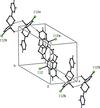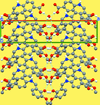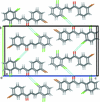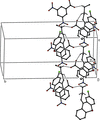issue contents
February 2019 issue

Cover illustration: Resorcinarene-based cavitands are macrocyclic synthetic compounds that are useful receptors for molecular recognition and versatile building blocks for crystal engineering. In particular, when the bridging groups connecting the phenolic hydroxyl moieties of the resorcinarene scaffold are quinoxaline rings, these cavitands become ideal hosts to interact with aromatic compounds, exploiting the ![[pi]](/logos/entities/pi_rmgif.gif) -basicity and hydrophobicity of their cavity. The present paper reports the synthesis of a new, deep cavitand bearing four 1,4 dioxane rings on the quinoxaline walls, and analyses in detail the molecular and crystal structure of its supramolecular complex with benzene. See: R. Pinalli, J. W. Trzcinski, E. Dalcanale & C. Massera [Acta Cryst. (2019). E75, 103-108].
-basicity and hydrophobicity of their cavity. The present paper reports the synthesis of a new, deep cavitand bearing four 1,4 dioxane rings on the quinoxaline walls, and analyses in detail the molecular and crystal structure of its supramolecular complex with benzene. See: R. Pinalli, J. W. Trzcinski, E. Dalcanale & C. Massera [Acta Cryst. (2019). E75, 103-108].
research communications






















































































 journal menu
journal menu




























































